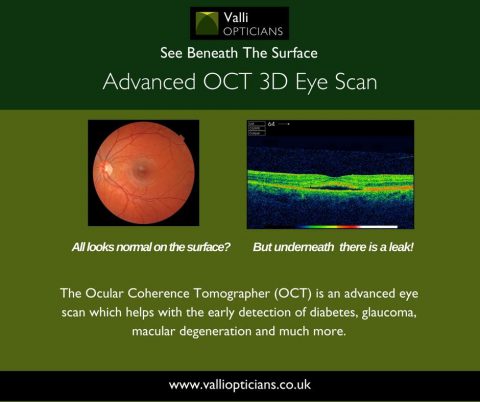10 Steps to Keeping Eye Fit

 by Melanie Hill of Valli Opticians
by Melanie Hill of Valli Opticians
We all know the importance of eating well and keeping fit for good health – be it going to the gym, playing sport or taking regular brisk walks. But what about keeping our eyes fit?
More than two million people in the UK are currently living with vision loss. What’s more, the number of people in the UK with sight loss is set to increase in line with population ageing: by 2050 the number of people with sight loss in the UK is projected to be nearly four million. (Source: Access Economics (2009) Future Sight Loss 1; updated with ONS population estimates for 2017.
Our sight is precious, so what steps can we all take to help protect our vision?
STEP 1 – KEEP UP TO YOUR EYE APPOINTMENTS

It is important to get your eyes tested at least every two years, even if you think your vision is fine because not all eye conditions have symptoms. This includes children’s eye appointments too.
STEP 2 – HAVE AN OCT EYE SCAN

This 3D eye scan allows your optician to see beneath the surface of the retina and is effectively an ultra-sound scan of the eye that can detect problems that are not always visible in a retinal photo or with conventional methods.
Using the 3D OCT our optometrists can take a digital photograph and a three- dimensional cross-sectional scan of the back of your eye in just one sitting. This allows us to instantly diagnose a number of common conditions. The scan is non-invasive, painless, simple and quick. What’s more, the software can automatically detect even the most subtle changes to the retina.
This gives you an invaluable ongoing record of the health and condition of your eyes. Common conditions identified through regular OCT screening include macular degeneration, diabetes, glaucoma, macular holes and vitreous detachments. Find out more about how these conditions affect your eyes here
STEP 3 – EAT RIGHT FOR HEALTHY SIGHT!

A lot of people don’t realise that specific ingredients can be extremely beneficial in maintaining good eye health. Foods that contain vitamins A, C and E; antioxidants and Omega 3 are essential for good eye health and can protect against eye conditions such as macular degeneration. Think brightly coloured foods – kale, spinach, blueberries, oily fish, sweet potatoes, bell peppers, broccoli and of course carrots are all excellent eye healthy produce.
STEP 4 – BE AWARE OF YOUR FAMILY’S EYE HEALTH HISTORY

Many eye conditions and diseases can be hereditary. Your optician will routinely ask if anyone in your family has a history of eye problems as this can show if you are at a higher risk of developing certain vision problems.
STEP 5 – DON’T SMOKE
We all know that smoking is bad for our health and this includes our eyes. If you smoke then stop and if you don’t smoke then don’t start. It’s as simple as that.
STEP 6 – WEAR PROTECTIVE GLASSES FOR SPORT

If you wear glasses then make sure you also have a specialist pair for use when playing particular sports. Whatever your choice of sport from skiing to cycling, golf to swimming, football to rugby, opticians can provide eye-wear solutions to help you keep on top of your game. This includes prescription swimming goggles, contact lenses and specialist glasses for many types of sport. Find out more about sports glasses.
STEP 7 – KEEP TO A HEALTHY WEIGHT
If you are overweight or obese then you could have an increased risk of developing diabetes or other systemic conditions which can lead to sight loss such as diabetic eye disease.
STEP 8 – PROTECT YOUR EYES FROM THE SUN

The number one priority when choosing a new pair of sunglasses should be the level of UV protection the lenses provide. Always check that your new sunglasses will provide 100% UV protection, this can also be referred to as UV400.
Remember that a dark lens isn’t necessarily UV protective just because it is dark. Your optician can advise you on the level of UV protection a lens will offer.
A good thing to remember is that a UV filter can also be applied to your everyday spectacles which will not alter the colour of the lenses, this will give good UV protection when you’re not wearing your sunglasses. Excessive exposure to UV is one of the risk factors with eye conditions such as macular degeneration and cataracts. Check out our Top Tip 6 for Choosing Sunglasses.
STEP 9 – GIVE YOUR EYES A BREAK

Prolonged computer use can cause symptoms such as:
- Eyestrain
- Visual fatigue
- Headaches
- Difficulty focusing
- Dry eyes
- Red eyes
- Postural problems
If you spend a long time looking at the computer or focusing on one thing you can have a tendency to forget to blink. So, every 20 minutes, take a break and look about 20 feet in front of you for 20 seconds to help reduce eyestrain. We call this the 20-20-20 rule!
STEP 10 – WEAR SAFETY GLASSES
Even if you already wear glasses there are potential risks to your eyes if you work in any type of industrial environment be it from machinery, sparks, metal fragments and even dust. Safety glasses are designed to protect your eyes and are available with prescription lenses where needed so you wouldn’t need to wear goggles over the top of your own spectacles. Always wear protective eyewear if it is required for your job and encourage your colleagues to do the same.


